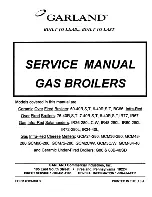
15
VENTING & AIR INLET PIPING
7. Test for spillage at the draft hood relief opening after
5 minutes of main burner operation. Use the flame of
a match or candle, or smoke from a cigarette, cigar,
or pipe.
Vérifier toute fuite à l’orifice de décharge du coupe-
tirage après que le brûleur ait fonctionné pendant 5
minutes. Utiliser la flamme d’une allumette ou d’une
chandelle ou encore la fumée d’une cigarette, d’un
cigare ou d’une pipe.
8. After it has been determined that each appliance
remaining connected to the common venting system
properly vents when tested as outlined above, return
doors, windows, exhaust fans, fireplace dampers and
any other gas-burning appliance to their previous
conditions of use.
Après avoir établi que les résidus de combustion de
chaque appareil qui demeure raccordé au système
commun sont adéquatement évacués lorsque soumis
au test décrit ci-dessus, remettre en place les portes,
fenêtres, portes intérieures, ventilateurs aspirants,
registres de foyer et appareils fonctionnant au gaz.
9. Any improper operation of the common venting system
should be corrected so that the installation conforms
with the National Fuel Gas Code, ANSI Z223.1/NFPA
54 or CAN/CGA B149 Installation Codes
.
Tout fonctionnement inadéquat du système
d’évacuation commun doit être corrigé de manière
à respecter les normes du National Fuel Gas Code,
ANSI Z223.1/NFPA 54 et/ou des Codes d’installation
CAN/ACG B149
.
10. When resizing any portion of the common venting
system, the common venting system should be resized
to approach minimum size as determined using the
appropriate tables located in the chapter “Sizing of
Category I Venting Systems,” of the National Fuel
Gas Code, ANSI Z223.1/NFPA 54 or CAN/CGA B149
Installation codes.
Lorsqu’il est nécessaire de modifier les dimensions
de toute portion du système d’évacuation commun,
ces dernières doivent être modifiées de manière à
respecter les dimensions minimums indiquées dans les
tableaux du chapitre « Sizing of Category I Venting
Systems » du National Fuel Gas Code,
ANSI Z223.1/
NFPA 54 ou des Codes d’installation CAN/ACG
B149.
















































